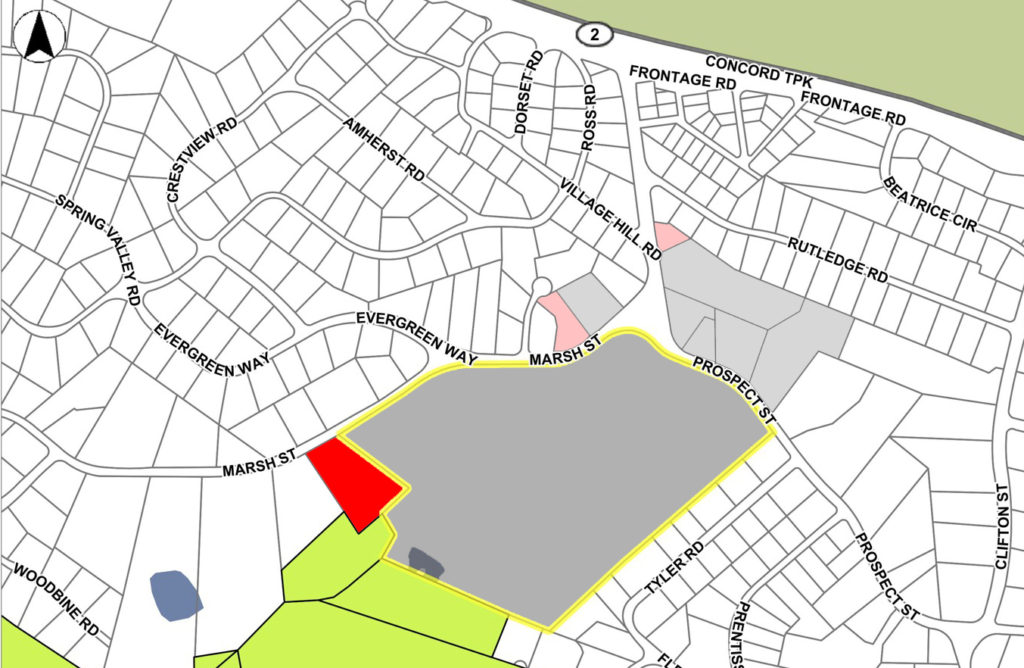
By Justin Roe
Belmont Hill School has always held itself out to be a good neighbor and a responsible member of our community. The Belmont Hill School Sustainability Club is proud to be “Mindful of the rising importance of promoting environmentally sustainable practices and environmental stewardship in our world today and in the future . . . to reduce our school’s impact on the environment and educate faculty and students alike about environmental issues in areas such as energy consumption, waste disposal, and climate change.” These are inspiring words. Nevertheless, Belmont Hill School has recently revealed plans to pave over a large section of existing woodland to build a new campus site across Prospect Street from their current campus.
The new development will be nearly as large as the school’s total current academic area, and its primary purpose—rather than providing direct support to their educational needs—will be a parking lot for an additional 138 cars. The head of school, Greg Schneider, says that the large parking lot is needed to allow the students to drive to school and also for faculty and parents to attend events. There will also be a new facilities maintenance building with still more parking for buses and maintenance vehicles. The project is likely to have a significant impact on Belmont, both environmentally and financially.
The project’s details reveal many environmental concerns. The area earmarked for construction consists of a densely wooded wildlife habitat that is home to deer, coyotes, foxes, raccoons, wood ducks, hawks, owls, frogs, and other wildlife. Not only is the land so densely wooded as to be mostly inaccessible to humans, but it also abuts a wetland oasis where animals have access to ponds and streams. All of this—the land, the trees, and the wildlife habitat—will be paved over for cars.

The Belmont Hill School’s property acquisitions. The dark gray portion shows the current campus: light gray areas were acquired prior to 2022: pink areas were purchased in 2022. Belmont Hill is seeking to purchase the area marked in red to the west of the main campus. Data provided by Justin Roe.
There is a concern about runoff from the parking lot, which brings with it oil, tailpipe emissions, and the general grime that comes with added traffic. That runoff could seep into the ground, find its way into the abutting wetlands, and contaminate the wildlife drinking water. Furthermore, the simple act of paving over the area will necessarily cause heat concentration typical of large parking lots.
The school administration has offered assurances that it intends to address these issues as best it can, but in the end, a parking lot is a parking lot and not a woodland. There is only so much they can do once the destruction has occurred.
Not only will Belmont be subjected to an unnecessarily large parking lot, but a new feature added to the Belmont Hill landscape will be two new exposed fuel tanks, one for gasoline and one for diesel, each containing hundreds of gallons of fuel. Given the recent town uproar regarding safety concerns with the new tanks at the Department of Public Works site, prompting the town to bury them rather than leaving them exposed for safety concerns, this addition to the plan is surprisingly tone-deaf.
Today’s news is full of accounts of people taking responsibility, and, more importantly, taking action to protect our environment. Countries are finally committing to substantial carbon reduction by 2030 and carbon neutrality by 2050, and employing innovative thinking to achieve those goals. Similarly, innovative companies are committing to electric technology and leaving legacy gas-based automotive companies in the dust. Why does innovative thinking seem to be so lacking at Belmont Hill School? When faced with overcrowded parking lots, the solution to tear down woodland and install a new, larger parking lot seems to be completely out of step with climate mitigation practices.
Where are the alternatives? Where are the bicycles? Where are the shuttles to Alewife and to other towns? Where is the commitment to recharging stations rather than installing new above-ground gas tanks? And perhaps more importantly, what will this teach Belmont Hill students who will be our next generation of leaders?
Town Will Lose Real Estate Tax Income
Belmont Hill School’s plans seem certain to damage the town of Belmont not only physically but fiscally. Over the last several years, Belmont Hill has been acquiring homes on Park Avenue, Marsh Street, and Prospect Street, a total of seven houses, covering about 10 acres.
The first of these houses is set to be demolished with the start of construction in April 2023. As a nonprofit educational institution, Belmont Hill School does not pay any taxes to the town to help maintain the services for police, roads, public schools, fire services, or indeed any of the public services the town provides (and the school uses). When these houses are torn down, the taxes paid to the town also disappear. The taxes on these homes amounts to about $30,000 to $35,000 per home, per year, resulting in a $210,000 to $245,000 reduction in the town’s annual income. In order to balance its budget, the town would have to find that money elsewhere, i.e., by raising taxes on the rest of us. This is a significant additional annual cost for the town and its residents to pay for a private parking lot and a maintenance facilities building for the exclusive use of the Belmont Hill School.
Belmont Hill School’s motto is “Providentia, Studium, Fidelitas” (Foresight, Effort, Loyalty). In today’s climate, both figurative and literal, this project seems to show anything but foresight. It is promoting cars over bicycles and public transport, gasoline and diesel over electric, and pavement over woodland. Any one of these on its own would and should raise the hackles of anyone claiming to care about our environment, about the world the next generation will live in.
Together, they make it clear that the school is concerned not so much with what they leave for the next generation but with what they can get before the tide of public opinion finally turns. As an educational establishment, the school doesn’t have to be concerned with the Belmont bylaws and regulations that you and I would have to conform to. As long as it is for “educational purposes,” the school can take advantage of the Dover Amendment (Massachusetts General Law Chapter 40A Section 3) to bypass some zoning restrictions, and the school is claiming that a parking lot, a maintenance building, and gas tanks are indeed educational. That’s certainly an education to me.
The truth is that by using this Dover Amendment and a $130 million endowment, the school can and will do just what they want, destroying a wildlife habitat area, negatively affecting climate change, and making the people of Belmont pay for it. Maybe our Select Board will do the right thing to protect Belmont.
So, this brings me back to the inspiring words from the Belmont Hill School’s website, “promoting environmentally sustainable practices and environmental stewardship in our world today and in the future.” Inspiring words indeed, but I suggest that the people of Belmont need more than just words. We need action.
Justin Roe is a Belmont resident.



Sorry, the comment form is closed at this time.